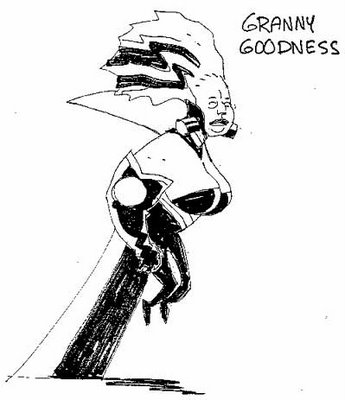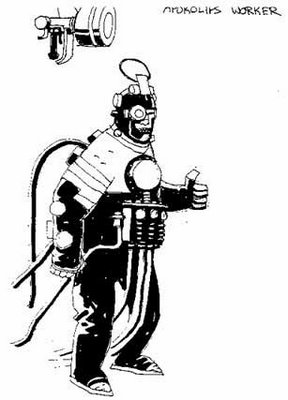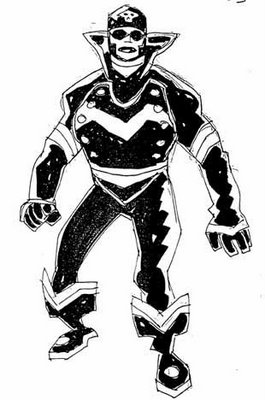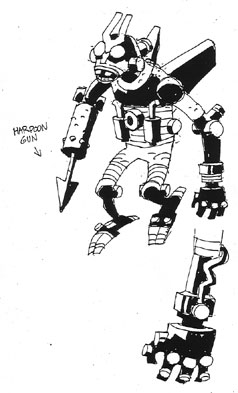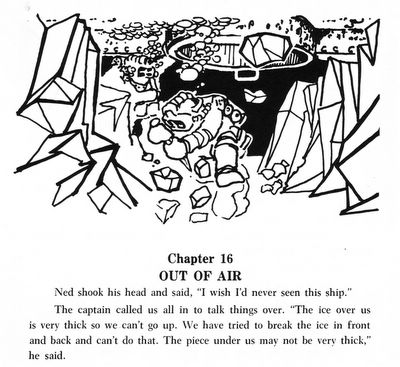Who'da thoughts that we'd ever see an animated B'wana Beast? He shows up at aboout the 2:15 mark in the clip below. Until then you can enjoy Zatanna's antics.
Tuesday, January 23, 2007
Sunday, January 21, 2007
Launched This Day: 1st Atomic Sub
One this day in 1954, the first atomic submarine, the U.S.S. Nautilus, was launched at Groton, Connecticut. All vessels previously known as "submarines" were in fact only submersible craft. Because of the nuclear power plant, the Nautilus could stay submerged for months at a time, unlike diesel-fueled subs, whose engines required vast amounts of oxygen. Nautilus demonstrated her capabilities in 1958 when she sailed beneath the Arctic icepack to the North Pole. Scores of nuclear submarines followed Nautilus, replacing the United States' diesel boat fleet. After patrolling the seas until 1980, the Nautilus is back home at Groton. link
Arctic Submarine TimelineAtomic Submarine has just been released by Criterion(!) in a nice, new boxed set called "Monsters & Madmen" along with The First Man Into Space, The Haunted Strangler, & Corridors of Blood all under a beautiful cover by Darwyn Cooke (we highlighted another of his Criterion covers HERE). The DVD Journal has reviewed the set and has this to say:
"The Atomic Submarine (72 minutes, Criterion no. 366) is to James Cameron's The Abyss what It! The Terror from Beyond Space is to Ridley Scott's Alien. When a nuclear-powered submarine, the Tiger Shark, sets out to investigate a series of mysterious disappearances near the Arctic Circle, its fearless crew finds itself besieged by electrical storms, an Unidentified Floating Saucer, and lots of hairy tentacles."Tomorrow’s Fear Becomes Today’s Nightmare!:
"There's something sublime in the hairy eyeball's "telepathic" baritone introduction to Arthur Franz: "So, Commander Holloway, as you Earth inhabitants would express it, we meet ... face to face!" Let's not forget the bombastic narrator ("Adapt a complicated guidance system to a huge ballistic rocket, convert it to a water-to-air intercept missile? It was foolish, it was insane, it was fantastic! But it was their only hope. And the Earth's only hope!"). And the Theremin-heavy musical score adds to the cheese factor with "electro-sonic" gusto."
Saturday, January 20, 2007
Steranko's Stolen Art

Characters © DC & Marvel Comics; Art © Steranko
"Likewise, I did NOT give Harry and the school the FOOM Poster original to sell or give away. It was Harry's understanding that his unique pop-culture collection be FOREVER maintained in his name. Instead, the institution has NEVER used the material for any significant purpose, except to sell it off, which is unreasonable, disgraceful, and unethical. What was to be a LIVING TRIBUTE to one of the founders of the Golden Age of Comics became a travesty, smearing the school and those involved with the scum of greed, lies, and hypocrisy."The stolen art was reproduced as a color poster for Marvel’s “FOOM” (Friends of ‘ol Marvel) but I received the above piece on the envelope that contained one of Steranko’s two volumes of “The History of Comics”—both highly recommended if you can find them anywhere.
Friday, January 19, 2007
The Flight of Bats

“The assumption has always been that bats evolved from some sort of flying squirrel-type animals,” says Swartz. “Gliding has evolved in mammals seven times. That tells us that it’s really easy for an animal with skin to evolve into a glider, but going from a square gliding wing to a long, skinny flapping wing has not happened seven times. It might have happened once. And now it doesn’t look like bats have any relationship to these gliding things.”
Bat wings are highly articulated, with more than two dozen independent joints and a thin flexible membrane covering them. Birds and insects can fold and rotate their wings during flight, but bats have many more options. Their flexible skin can catch the air and generate lift or reduce drag in many different ways. During straightforward flight, the wing is mostly extended for the down stroke, but the wing surface curves much more than a bird’s does – giving bats greater lift for less energy. During the up stroke, the bats fold the wings much closer to their bodies than other flying animals, potentially reducing the drag they experience. The wing’s extraordinary flexibility also allows the animals to make 180-degree turns in a distance of less than half a wingspan. link
Direct measurements of the kinematics and dynamics of bat flight. 2007. Xiaodong Tian et al 2006 Bioinspir. Biomim. 1 S10-S18
Tuesday, January 16, 2007
Vaughn Bode's 20,000 Leagues Under the Sea: Part 7
Back in the 60’s Vaughn Bodé illustrated a number of classics that had been rewritten for “reading challenged” kids. The books were published by Frank E. Richards and sold exclusively to schools.
Because these books are almost impossible to find at reasonable prices I’ll be posting all the illos from the best book of the bunch, “Jules Verne’s ’20,000 Leagues Under The Sea” in eight installments.
Read: Part 1 Part 2 Part 3 Part 4 Part 5 Part 6 Part 7 Part 8
Because these books are almost impossible to find at reasonable prices I’ll be posting all the illos from the best book of the bunch, “Jules Verne’s ’20,000 Leagues Under The Sea” in eight installments.
Read: Part 1 Part 2 Part 3 Part 4 Part 5 Part 6 Part 7 Part 8
All art © the estate of Vaughn Bodé
Sunday, January 14, 2007
Subscribe to:
Posts (Atom)







